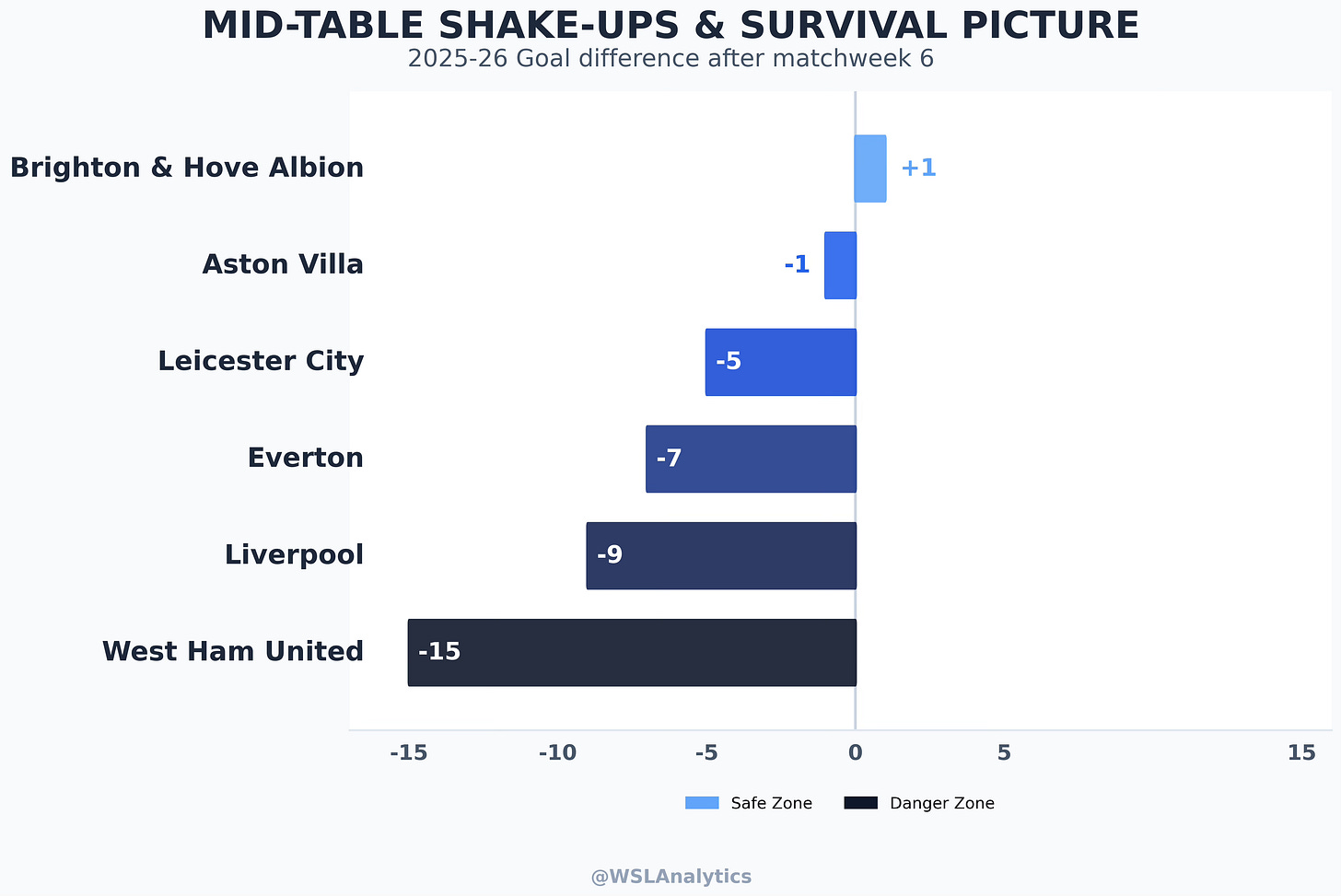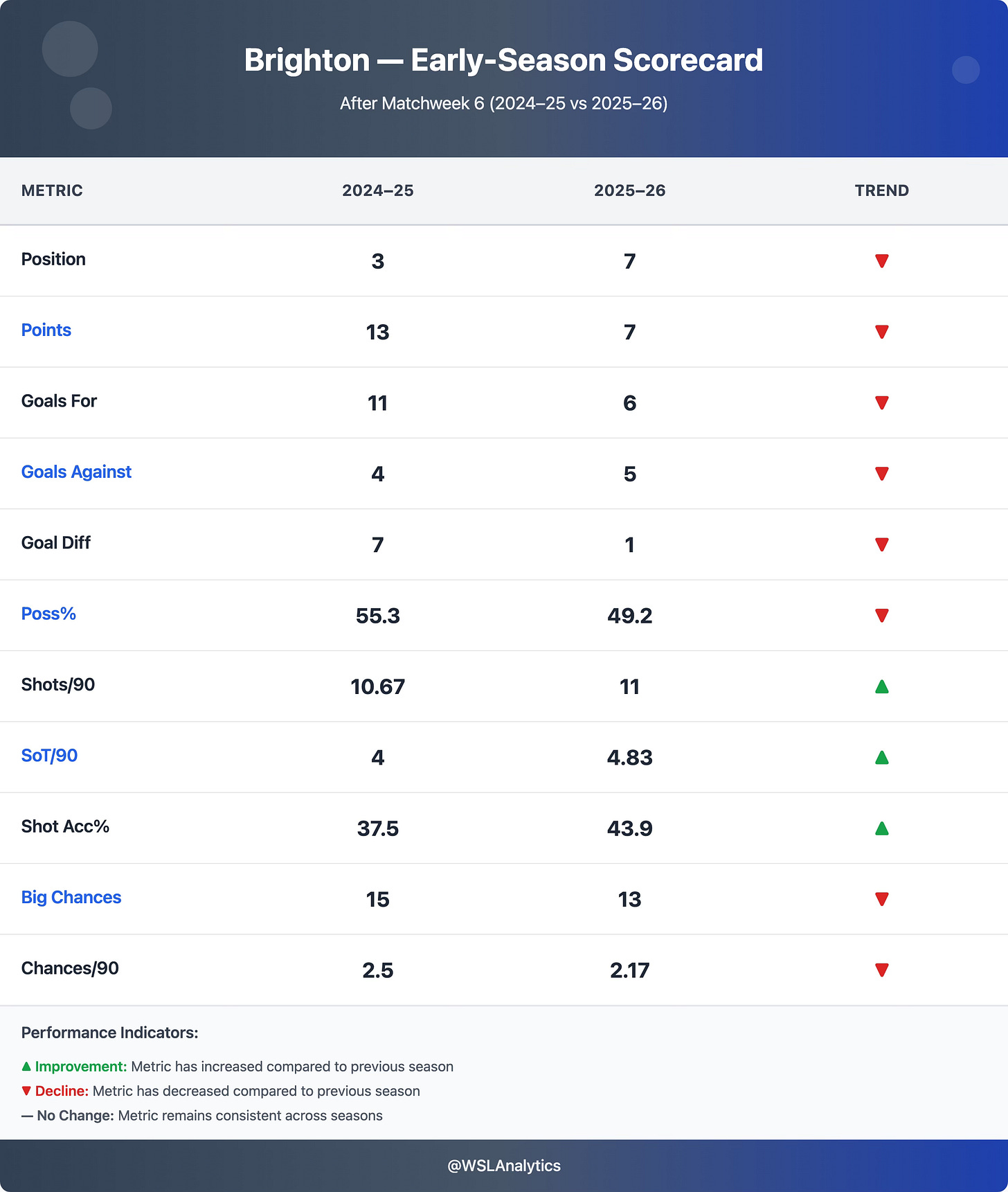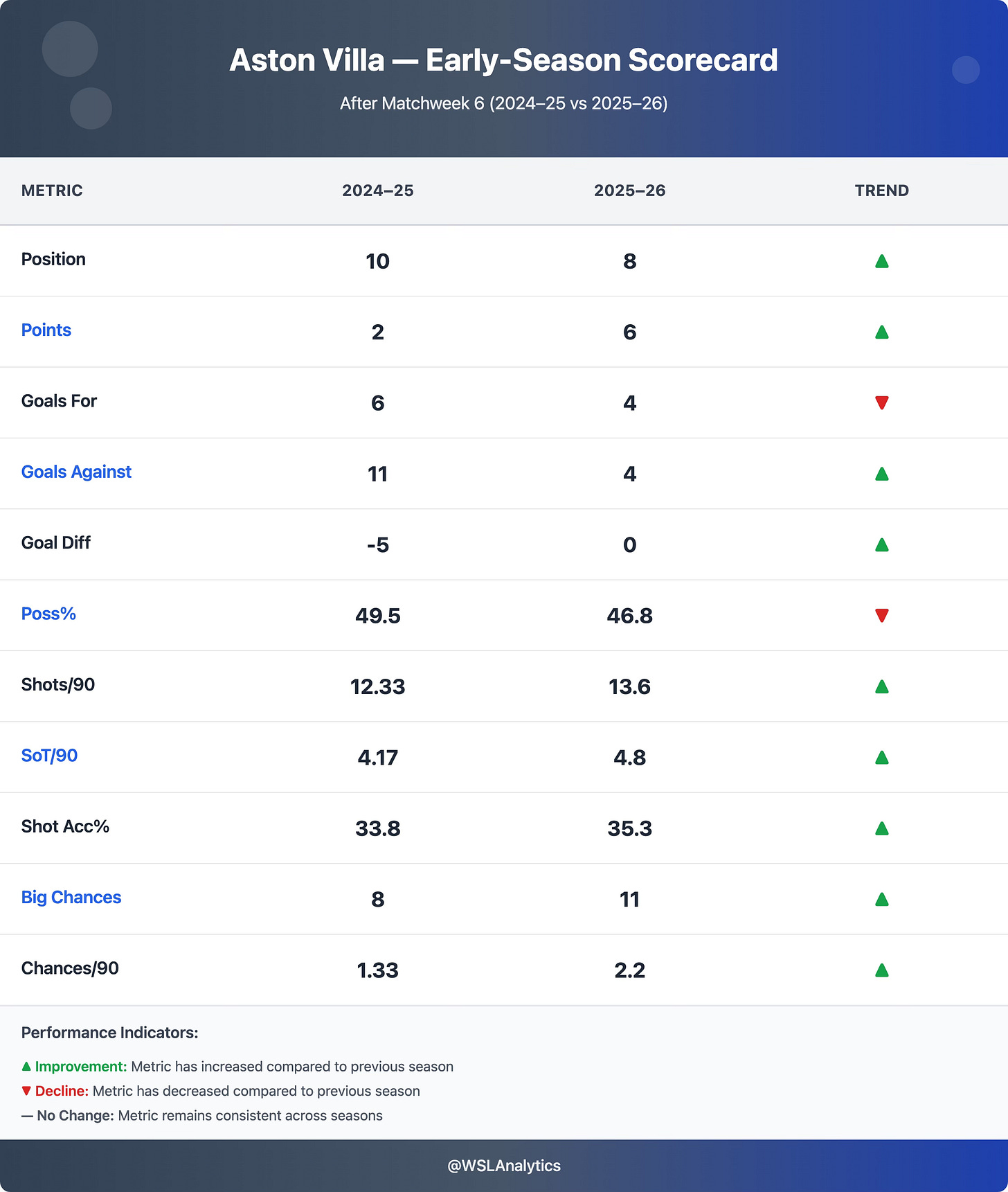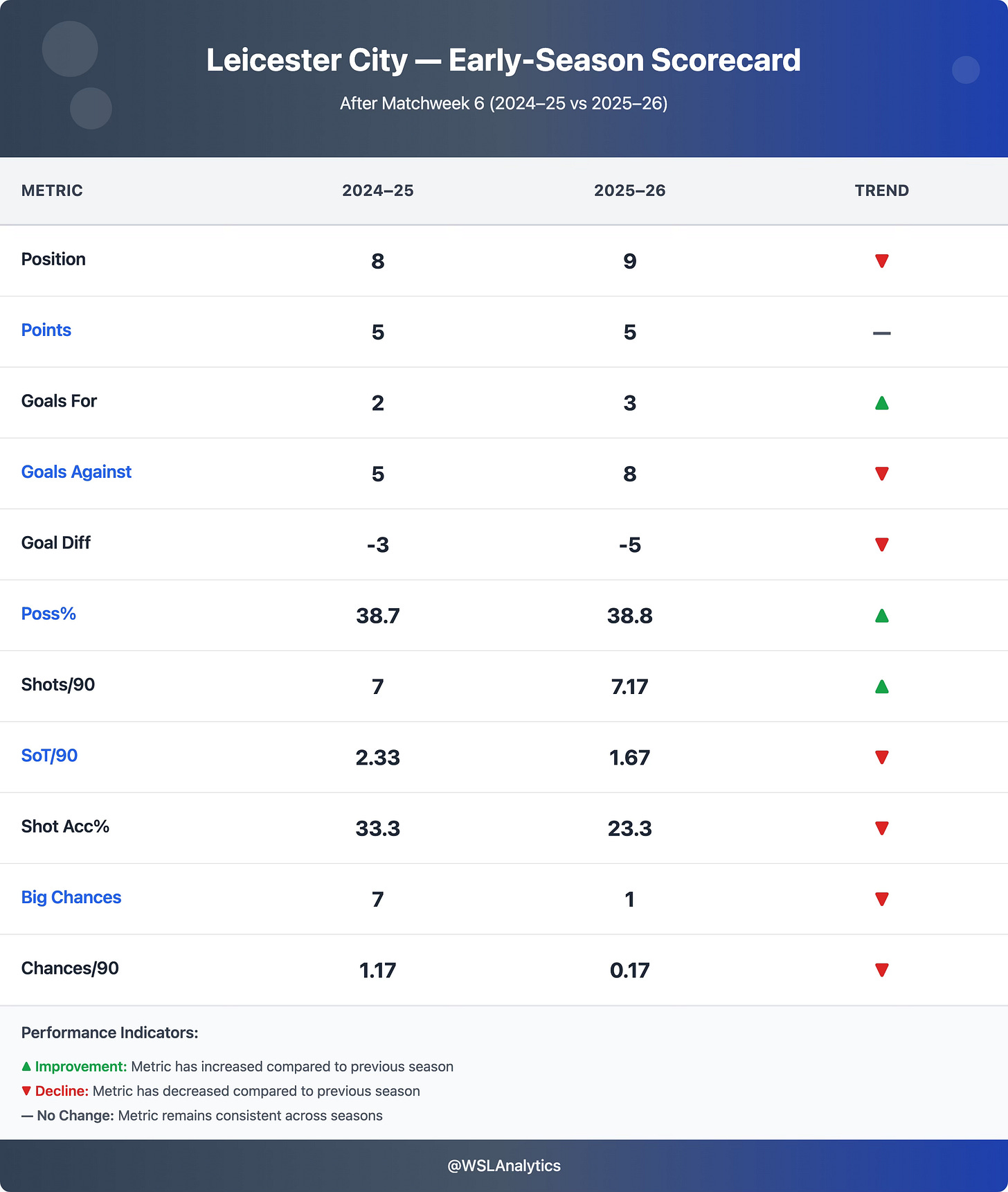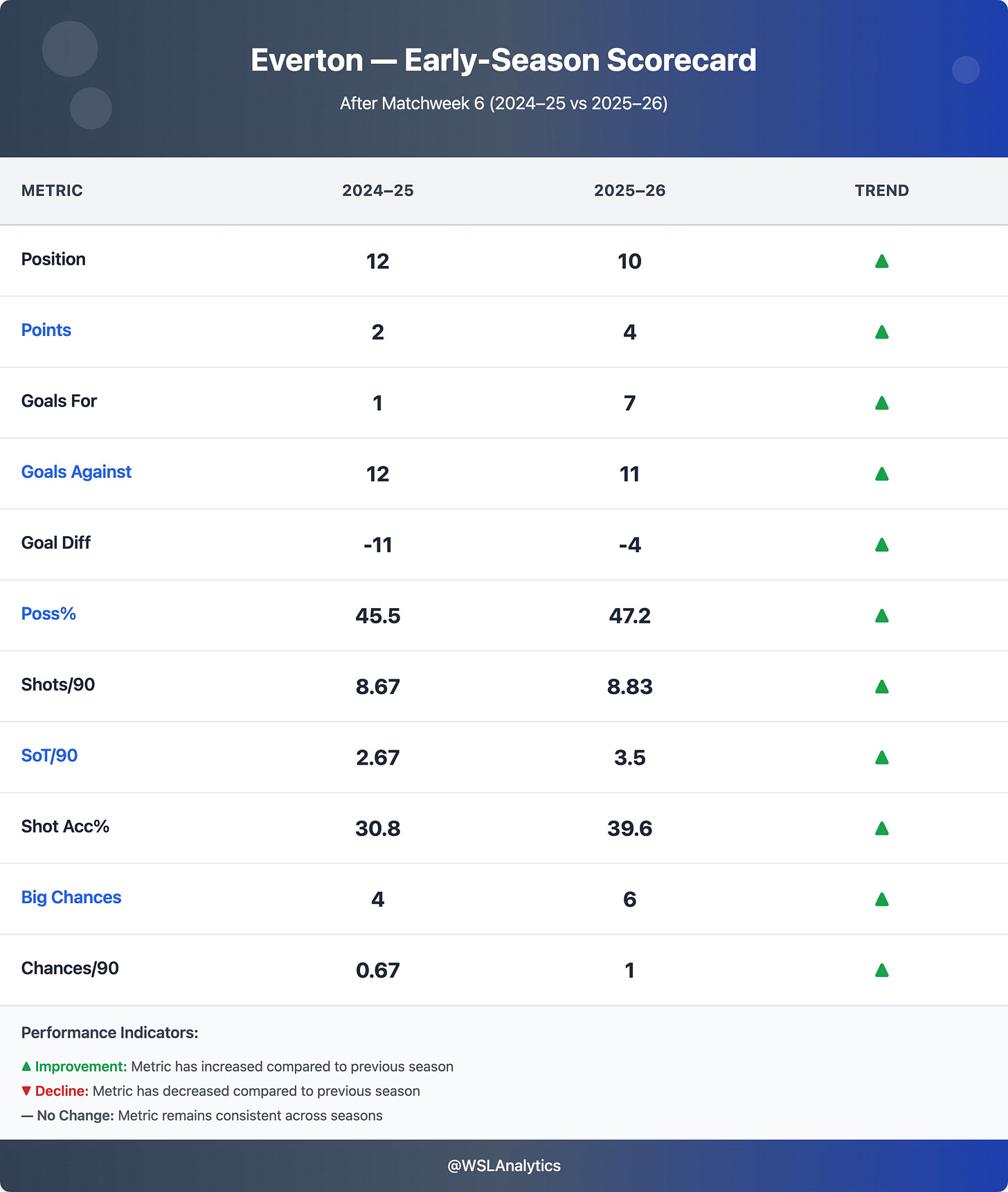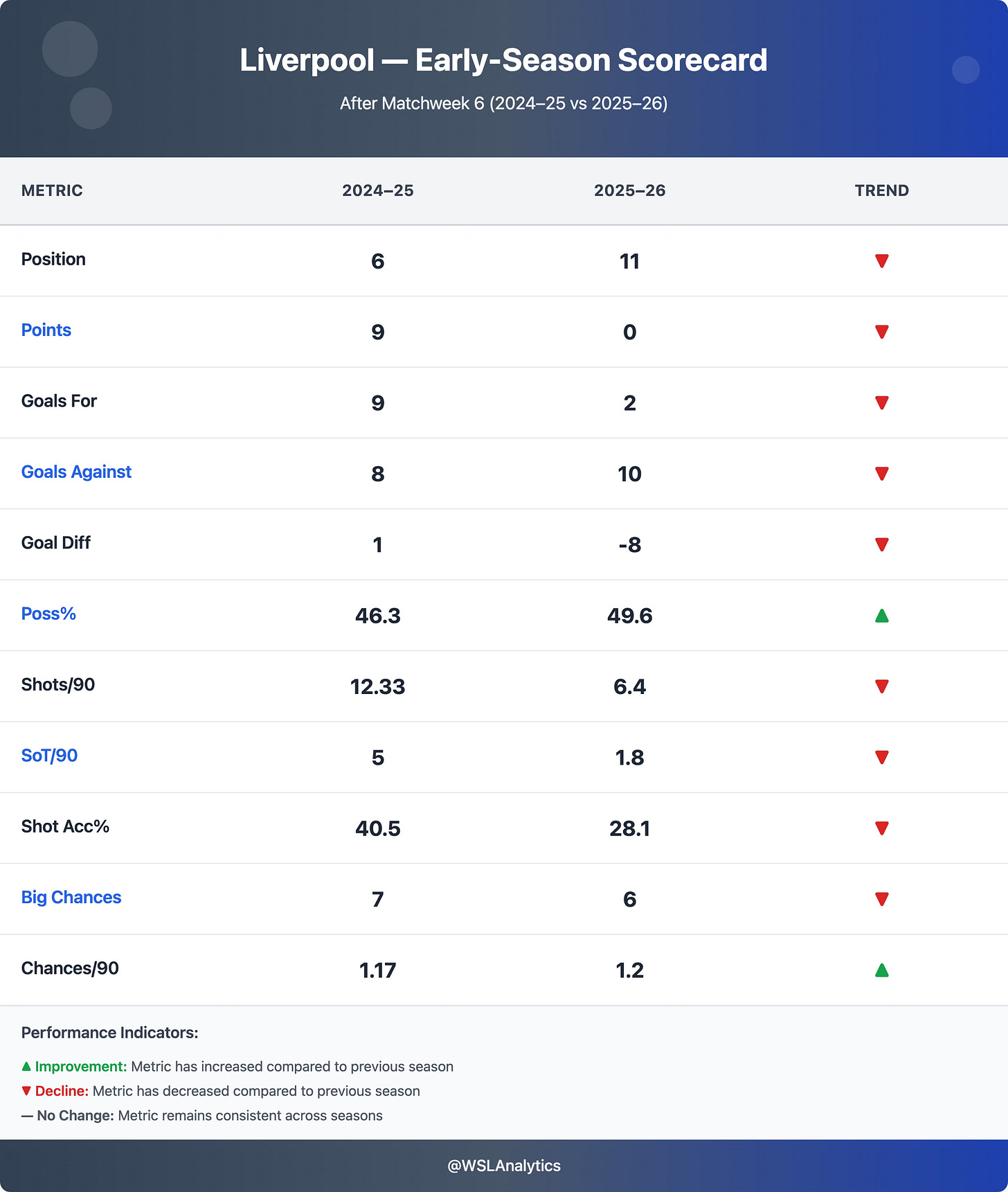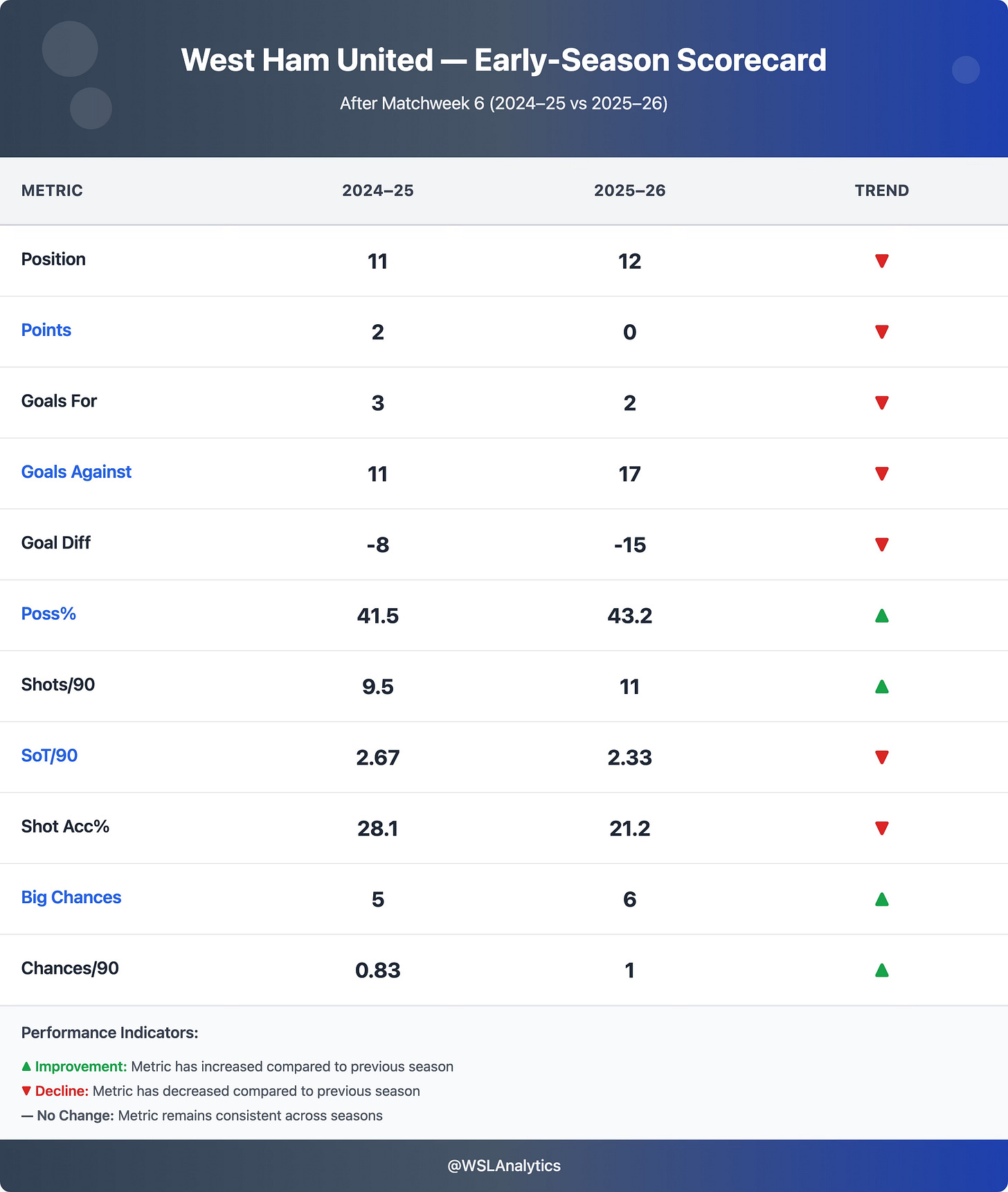State of the League Report – Part 3: WSL 2025–26 Mid-Table Shake-Ups & Survival Picture
Brighton’s reversion to the mean, Villa’s defensive resurgence, and Liverpool/West Ham crisis are reshaping the 2025–26 WSL’s lower half.
Introduction
After analysing the title front-runners in Part 1 – The Contenders and the chasing pack in Part 2 – The Challengers, this third instalment of our State of the League Report turns to the volatile middle and lower tiers, the zone where stability, survival, and ambition blur.
Brighton’s levelling-off, Villa’s defensive rebuild, and Leicester’s stagnation headline a landscape where every point feels pivotal. Beneath them, Everton’s inconsistency, Liverpool’s implosion, and West Ham’s free-fall define the battle line for safety.
This is where the margins are cruel, and efficiency, not dominance decides who climbs, who clings, and who slides.
The Mid-Table Shake-Ups
Brighton & Hove Albion (3rd in 2024–25, 7th in 2025–26)
Creation steady, finishing cooled; less control on the ball, defence broadly intact.
Scoreboard slide. Brighton’s bright start from last season hasn’t carried over: they have seven points from six matches (two wins, one draw, three losses), down from 13 at this stage last season. Goals scored have dropped from 11 to 6, while goals conceded have risen marginally from 4 to 5, trimming their goal difference from +7 to +1.
Attacking shift: volume steady, conversion down. Chance creation remains respectable, 51 chances and 13 big chances so far, broadly in line with last season, and shot accuracy has improved from 37.5% to 43.9%. Despite that uptick in precision, conversion remains the issue. Brighton are taking slightly more shots per match (10.7 vs 11.0) and hitting the target more often (4.0 vs 4.8), however, they are turning fewer of those efforts into goals.
Control profile: possession dip. Average possession has fallen from 55.3% to 49.2% (–6.1 percentage points). The Seagulls are spending longer without the ball and operating in more transitional phases, limiting their ability to sustain pressure and control tempo the way they did at this stage last season.
Defensive baseline intact. The back line has held up relatively well, conceding just one more goal than last season at this stage. Brighton’s decline is therefore less about defensive deterioration and more about the combined effect of reduced control and cooler finishing.
Data verdict: Brighton remain a capable side with enough chance creation to challenge mid-table rival, but their drop in possession and shot conversion has capped their early-season ceiling. If they can get their finishing back to normal and midfield control returns, they can quickly re-establish themselves in the top-six mix.
Aston Villa (10th in 2024–25, 8th in 2025–26)
Defence rebuilt, performances steadier, results trending upward.
Marked improvement. Aston Villa have made clear progress from last season’s sluggish opening. After six games of 2024–25 they had just two points and no wins; this time they have six points from five matches, already tripling last year’s total while playing one game fewer. Their position has improved from tenth to eighth, reflecting a more competitive edge and greater resilience in tight games.
Defensive transformation. The most dramatic shift has come at the back. Villa have conceded only four goals so far, compared with eleven at the same stage last year. That equates to roughly 0.8 goals against per match, down from nearly 1.8 last season. This is a major improvement. The goal difference has also swung from minus five to level. Three clean sheets already underline the newfound solidity.
Attacking output modest but functional. Goals scored have dipped slightly, from six to four, yet attacking production metrics are up: shots per match have risen from 12.3 to 13.6, shots on target from 4.2 to 4.8, and big chances from eight to eleven. Shot accuracy has also improved to 35.3%. Rachel Daly remains heavily involved in creation and finishing, though Villa’s attack still lacks a clinical edge to convert volume into consistent scoring.
Possession and control. Possession has eased from 49.5% to 46.8%, reflecting a more pragmatic approach built around structure and compactness rather than open exchanges. The tactical shift appears intentional – trading some control for stability.
Data verdict: Villa look more assured than at this point last season. Defensive resilience has replaced volatility, and their ability to grind out points suggests mid-table security rather than a survival fight. If the attacking efficiency improves even slightly, Villa should push comfortably into the league’s middle pack.
Leicester City (8th in 2024–25, 9th in 2025–26)
Defensively competitive, but creativity crisis keeps progress stalled.
Stagnant scoreboard. Leicester find themselves in almost the same position as last season: five points from six matches, with one win, two draws, and three defeats. Their record is identical to this stage last year, and their league position ninth, reflects a side that has stabilised but not advanced.
Attacking output worryingly low. Leicester have scored only three goals in six matches, just one more than at this point in 2024–25. Creativity has collapsed, with only one big chance created compared to seven last season. They average 7.2 shots per match – the lowest in the league, and their shot accuracy has dropped sharply from 33.3% to 23.3%.
Defensive shape holding up. At the back, Leicester have conceded eight goals compared to five last season, a modest rise but still within a competitive range. They’ve been involved in several tight games, including a goalless draw away at Aston Villa that highlighted their defensive organisation. The back line remains the team’s most reliable component, even as attacking struggles persist.
Managerial reset and outlook. New manager Rick Passmoor has inherited a disciplined but low-scoring side. His early focus on defensive structure has kept Leicester competitive in most fixtures, yet the lack of attacking spark continues to hold them back. The Foxes have now gone 19 away WSL games without a win, a run stretching back to January 2024, underlining the scale of their attacking problem.
Data verdict: Leicester remain organised and difficult to beat, but their failure to create and convert chances is a growing concern. Unless they rediscover a consistent scoring threat they risk being pulled into the survival zone despite their defensive stability.
The Survival Picture
Everton (12th in 2024–25, 10th in 2025–26)
Attack revived, defence still unreliable, home comfort elusive.
Modest progress. Everton have taken small but meaningful steps forward after last season’s dismal start. At this stage in 2024–25, they had two points and a single goal to their name; this season they have doubled their points to four and scored seven times. The jump in attacking output is dramatic – a sevenfold increase. It is important though to note 57% of those 7 goals came from one match.
Attack finding rhythm. Everton are averaging 8.8 shots per match (virtually unchanged from last year) but have become far more efficient in front of goal. Their shot accuracy has improved from 30.8% to 39.6%, while the big-chance count has risen from four to six. Seven goals from 53 shots translates to roughly a 13% conversion rate, a major step up from last season’s 2%.
Defensive issues persist. Despite the improved attack, defensive lapses continue to undermine progress. Eleven goals conceded in six games is only marginally better than the 12 shipped at this stage last season, and their goal difference of minus four still reflects fragility at the back. Everton’s home record remains particularly troubling: they have lost all three home matches so far, extending a run of five home games without a win (4 losses, 1 draw) dating back to last season.
Data verdict: Everton look more dynamic and confident in attack, but the defensive structure and home record still lag behind. The balance has improved enough to keep them competitive, but unless they stem the goals against, the fight to avoid the survival zone may linger.
Liverpool (6th in 2024–25, 11th in 2025–26)
Confidence drained, attack blunt, transition turbulence.
From stability to struggle. Liverpool’s downturn is one of the season’s starkest. At this stage last year, they had nine points from six matches and sat comfortably in mid-table. This time, they remain winless and without a poin after five games, languishing in 11th place. Two goals scored and ten conceded mark a sharp decline from the nine-for, eight-against profile of 2024–25. The swing in goal difference from plus one to minus eight underscores the depth of their early-season slump.
Attacking collapse. The Reds are averaging just 6.4 shots per game, less than half last year’s output of over 12, and their shot accuracy has dropped from 40.5% to 28.1%. They’ve created only six big chances across their matches, reflecting a clear shortage of final-third productivity. Their possession share has actually risen to 49.6%, but most of it has been sterile – ball control without penetration.
Managerial transition. The summer brought significant change, with the arrival of Gareth Taylor. Taylor’s tenure has begun with turbulence: Liverpool are still adapting to his positional and passing-focused style, and performances have lacked sharpness in both boxes. The manager has called for patience, stressing that the team “deserves more” from several narrow losses but the results column remains unforgiving.
Defensive strain. Ten goals conceded from five games isn’t catastrophic, but Liverpool’s habit of losing by fine margins highlights a fragile mentality. The Reds have yet to hold onto a lead or close out a game, a sign of eroded confidence more than structural collapse.
Data verdict: Liverpool’s numbers paint the picture of a side in transition, more possession, but far less punch. The pieces are there for recovery, especially as fixtures ease, but unless the attack finds fluency and belief returns, they risk remaining in the survival zone.
West Ham United (11th in 2024–25, 12th in 2025–26)
Defensive collapse, blunt attack, and confidence draining fast.
Bleak start. West Ham have endured a torrid opening to the 2025–26 campaign. Six matches in, they remain without a point and sit bottom of the table, having lost all six games. This is a regression from last season’s slow start, when they at least managed two draws and two points by this stage. Their goal difference has worsened from minus eight to minus fifteen, underlining the scale of the downturn.
Defensive crisis. The Hammers have conceded a league-high 17 goals, almost three per game – compared with 11 at the same point last season. They are yet to record a clean sheet and have been on the receiving end of several heavy defeats. Errors in defensive organisation, vulnerability from set pieces, and inconsistent goalkeeping have all contributed. The team often concedes early, leaving themselves chasing games and exposing further gaps in shape.
Attacking struggles. At the other end, the story is same. Two goals scored in six matches is joint-lowest in the league, despite taking 66 shots, which by the way is roughly the same volume as Brighton and more than Tottenham or Leicester. The problem is efficiency: a conversion rate of just 3% and shot accuracy of 21.2% are both league-worst figures.
Manager under pressure. Rehanne Skinner’s side have shown flashes of competitiveness — three of their six losses have been by a single goal — but morale appears fragile. Heads drop quickly after conceding, and the defensive confidence of previous seasons has evaporated. Skinner has called for resilience and focus, but results continue to slide, with the team already facing an uphill climb to safety.
Data verdict: West Ham look the league’s most vulnerable side by both numbers and momentum. Conceding heavily and finishing poorly is a bad combination, and unless they can stabilise defensively and find sharper end product, the survival battle will become increasingly likely. One win could spark a revival, but right now, the metrics point to a team in free fall.
Conclusion – The Shape of the Bottom Half
The mid-table and survival zones tell two parallel stories.
Brighton and Villa show measured stability and renewed defensive discipline; Leicester and Everton hover between promise and limitation; Liverpool and West Ham are precariously on the edge.
Across this half of the table, efficiency is the key – those who convert their often hard to find chances into goals will dictate their destiny.
Next: In Part 4 and the final part of this series, we would focus on the League-Wide Trends, Efficiency & Attendances – a deep dive into scoring distribution, defensive balance, table competitiveness, and the 2025–26 attendance landscape.
If this breakdown was useful, please consider subscribing and sharing – and join the conversation on X (Twitter) @WSLAnalytics for live WSL insights all weekend.


